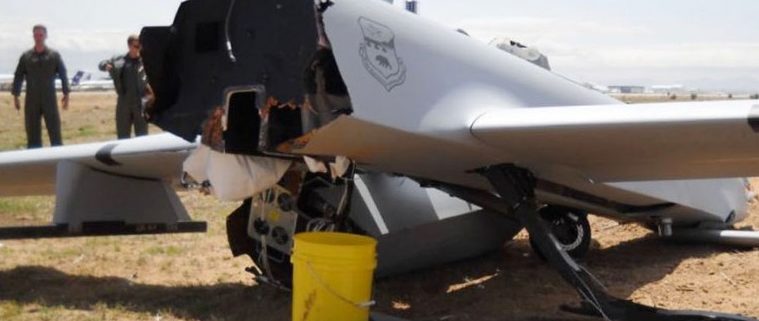Unmanned Aerial Vehicles (UAVs) crash. A lot.
Consider the chart below, which is for “Class A” accidents, the most serious designation. As you can see, at all times, for all platforms, UAVs have a significantly higher crash rate than manned aircraft.
Click to expand table
The Defense Department maintains that the UAVs are relatively new, and that as we learn how to fly them better, the rate of accidents goes down. This assertion appears to be true. However, the rate of UAVs falling from the sky is still frequent enough to give anyone pause when pondering their integration into domestic airspace.
Why are UAVs so prone to crashing? In a rare burst of actual journalism, the Washington Post has conducted an in-depth study of this issue (the article is worth reading in its entirety). They identify four major causes:
“•A limited ability to detect and avoid trouble. Cameras and high-tech sensors on a drone cannot fully replace a pilot’s eyes and ears and nose in the cockpit. Most remotely controlled planes are not equipped with radar or anti-collision systems designed to prevent midair disasters.
• Pilot error. Despite popular perceptions, flying a drone is much trickier than playing a video game. The Air Force licenses its drone pilots and trains them constantly, but mistakes are still common, particularly during landings. In four cases over a three-year period, Air Force pilots committed errors so egregious that they were investigated for suspected dereliction of duty.
• Persistent mechanical defects. Some common drone models were designed without backup safety features and rushed to war without the benefit of years of testing. Many accidents were triggered by basic electrical malfunctions; others were caused by bad weather. Military personnel blamed some mishaps on inexplicable problems. The crews of two doomed Predators that crashed in 2008 and 2009 told investigators that their respective planes had been ‘possessed’ and plagued by ‘demons.’
• Unreliable communications links. Drones are dependent on wireless transmissions to relay commands and navigational information, usually via satellite. Those connections can be fragile. Records show that links were disrupted or lost in more than a quarter of the worst crashes.”
The problem of limited sight and sound is nothing to sneeze at. There was an incident of a $3.8 million Predator crashing, because the pilot did not realize the UAV was flying upside-down.
For this and other reasons, pilots do not like flying the UAVs. One pilot is quoted by the Washington Post as saying:
“The problem is that nobody is comfortable with Predator. Nobody,” the pilot said, according to an interview transcript. He called the malfunction-prone drone “the most back-assedward aircraft I ever flown.”
In addition to poorer visual acuity, Predators are also slower than manned aircraft. UAV operators have complained that aviation personnel, such as air traffic controllers, often fail to account for the UAV’s limited speed and visual capabilities.
Predators are lighter than manned aircraft and lack redundant systems, such as engines. This makes mechanical problems a lot more serious for UAVs.
As it is with manned aircraft, “pilot error” for UAVs is a complex issue. One of the main attractions for UAVs is that they can stay in the air longer than their manned counterparts. Ideally, the lengthy mission is shared between 2 or more pilots. However, a shortage of trained pilots has meant that UAV operators are putting in extended shifts. Of course, this increases the odds of pilot error.
Furthermore, UAVs are flown by teams, i.e. sensor operators as well as pilots. These teams may be responsible for more than one UAV at a time. The more people involved in a task, the more points of failure are possible.
Congress has ordered the Federal Aviation Administration (FAA) to issue rules for domestic integration of UAVs by September 2015. UAV promoters have accused the FAA of dragging its feet, but considering the poor adjustments that the Air Force and other institutions have made in switching from manned to unmanned vehicles, and the alarming crash rate, bureaucratic reluctance seems reasonable.
Some have argued that the integration of UAVs into domestic airspace should be easier than that of unmanned systems on the ground or in the water. Fewer obstacles, fewer people, and fewer competing manned vehicles. Developers of non-aerial unmanned vehicles should pay special attention to the legal and political challenges faced by UAVs for these may foreshadow the problems of integrating autonomous cars, remotely controlled ships, and even domestic robots.




